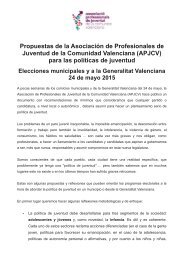c39dc
c39dc
c39dc
Create successful ePaper yourself
Turn your PDF publications into a flip-book with our unique Google optimized e-Paper software.
enhancing learning for young people with fewer opportunities and/<br />
or at risk of social exclusion and advocates for the strengthening of<br />
its recognition and validation 65 . The Lifelong Learning and the Youth<br />
in Action programmes (as developed further below in this section)<br />
have also been instrumental in this respect.<br />
Thus, the 2009 Council Conclusions on the new Strategic framework<br />
for European cooperation in the field of education and training ("ET<br />
2020") reiterated the equal importance of all different kinds of<br />
learning – formal, non-formal and informal learning – to make lifelong<br />
learning a reality. This includes, amongst other things, strengthening<br />
the structures for volunteering and youth participation, and<br />
supporting the acquisition of key skills through non-formal<br />
educational activities, as a supplement to formal learning or as an<br />
incentive to reintegrate back into the formal education system. Nonformal<br />
education is thus acknowledged at European level and<br />
national level as a key component of the lifelong learning approach 66 .<br />
The European Union has also for long advocated the importance of<br />
making non-formal and informal learning visible through the<br />
validation of non-formal and informal learning, to ensure that nonformal<br />
learning is recognised through different means and at different<br />
levels (social, political, individual) 67 . The European principles 68 and<br />
guidelines 69 for the validation of non-formal and informal learning and<br />
the periodic production of a European Inventory on the Validation of<br />
non-formal and informal learning are examples of this. Furthermore,<br />
the upcoming Council recommendation on the validation of nonformal<br />
and informal learning will give the subject of recognition a new<br />
dynamism focusing on aspects such as guidance and information,<br />
reliability of instruments and trust of stakeholders 70 .<br />
Specifically in the youth field, with the 2009 Council Resolution of 27<br />
November 2009 on a renewed framework for European cooperation<br />
in the youth field (2010-2018 71 ), non-formal education became for the<br />
first time a priority for policy cooperation in the youth area at<br />
European level 72 . The Strategy underlines that non-formal education<br />
for young people should be supported to contribute to lifelong<br />
learning in Europe. This is done by developing its quality, recognising<br />
65 Schild, J. (2012) ‘From Pathways to Pathways 2.0’ Coyote, n.18, pp. 7-11.<br />
66 Hawley, J., Souto-Otero, M. and Duchemin C. (2010) ‘2010 update of the European Inventory on validation of non-<br />
formal and informal learning –Final report’ GHK Consulting.<br />
67 European Youth Forum (2005) Policy paper on Recognition of non-formal education: confirming the real<br />
competences of young people in the knowledge society. COMEM 0716-05.<br />
68 Council of the European Union (2004) Conclusions of the Council and representatives of the governments of<br />
Member States meeting within the Council on common European principles for the identification and validation of<br />
non-formal and informal learning. (EDUC 118 SOC 253, 18 May 2004).<br />
69 CEDEFOP (2009) European guidelines for validating non-formal and informal learning. Luxembourg, Office for<br />
Official Publications of the European Communities.<br />
70 Schild, J. (2012) ‘From Pathways to Pathways 2.0’ Coyote, n.18, pp. 7-11.<br />
71 Council Resolution of 27 November 2009 on a renewed framework for European cooperation in the youth field<br />
(2010-2018) (2009/OJ C 311/01).<br />
72 Council of Europe and European Union (2011) Pathways 2.0 towards recognition of non-formal learning/ education<br />
and of youth work in Europe. Strasbourg and Brussels, January 2011.<br />
25




